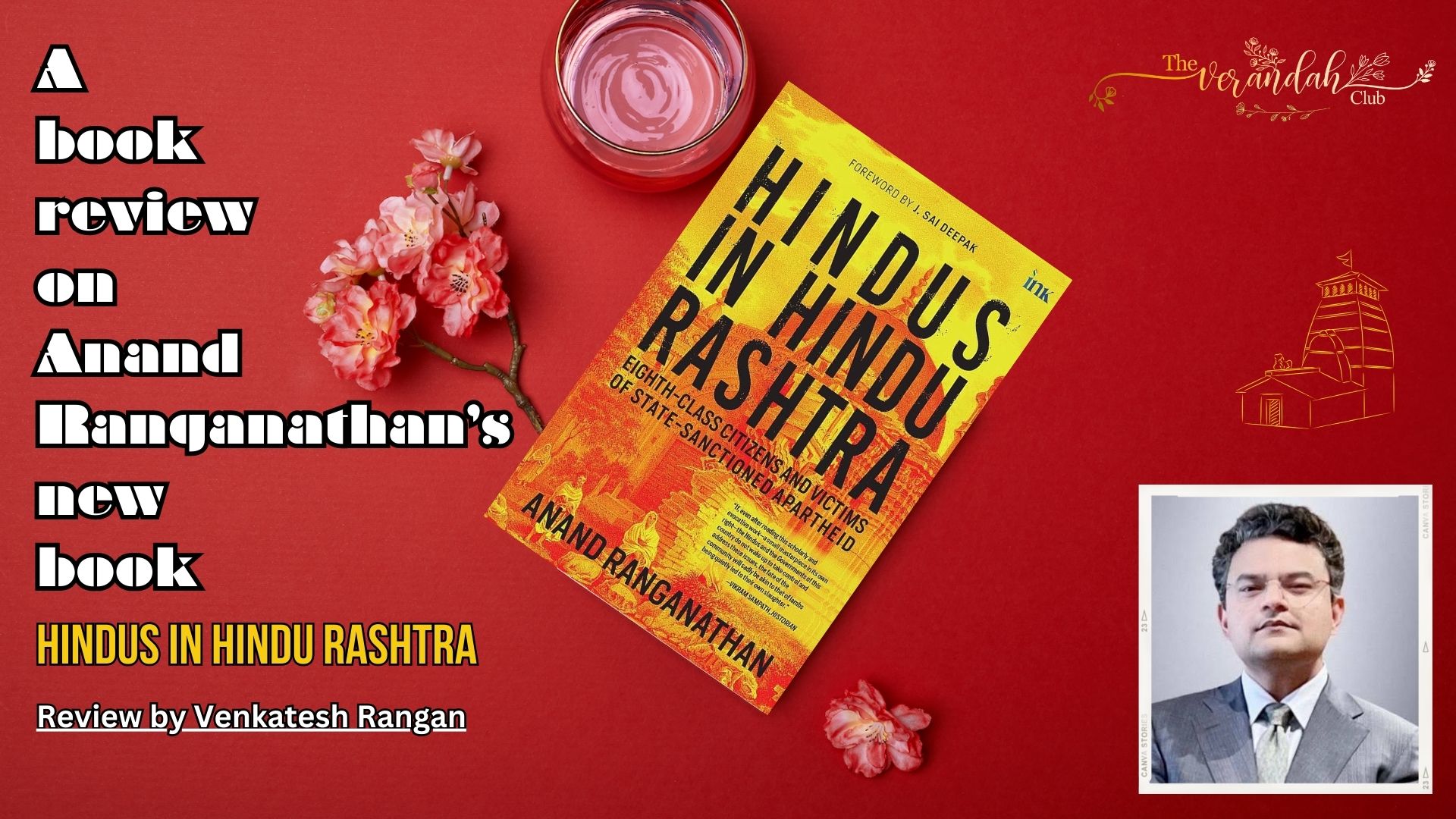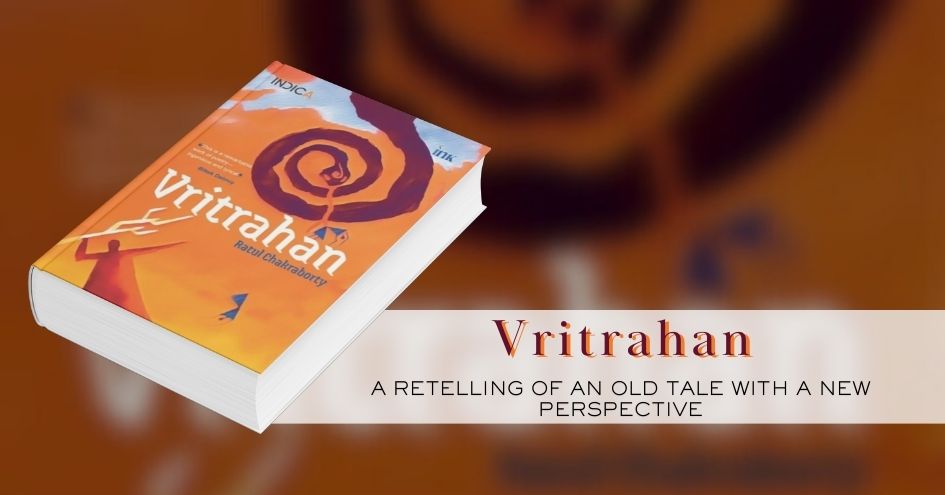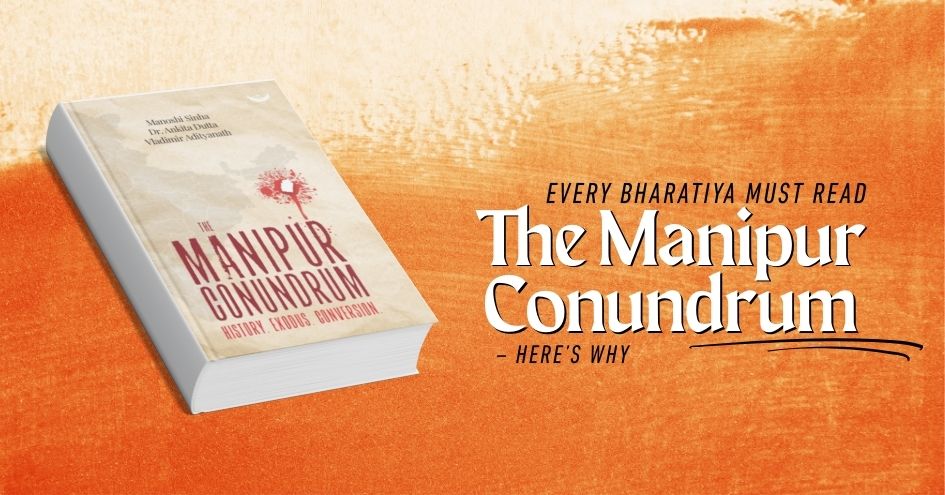
Hindus in Hindu Rashtra: Eight-class citizens and victims of State-Sanctioned Apartheid: Anand Ranganathan
Publisher: BluOne Ink
Review by Venkatesh Rangan
Basic premise:
Anand Ranganathan unambiguously states his main argument in the sub-title of the book itself. Forget equal or first class citizens. Hindus of modern Bharat – with a near 80% Hindu majority – are living as per the author as “eighth class citizens and victims of state sanctioned apartheid”. The book does not hold back from criticizing all governments, past or present and focusses more on institutional structures, laws and mindsets rather than on political parties per say. With the main argument laid out in the sub-title, the author explains 8 reasons why the argument holds valid and true.
Review:
Ruthlessly blunt, fearless, sharp, incisive – these are the words which precisely come to mind when the very mention of Anand Ranganathan, erudite public intellectual and fearless nationalistic thinker is made. What makes the allure even more awe-inspiring is the circumstances of Shri Ranganthan’s intellectual environment and personal belief systems. A scientist and academic from Special Centre for Molecular Medicine from Jawaharlal Nehru University – an institution associated in popular memory with the infamous “tukde-tukde” ecosystem – Ranganthan seems a complete antithesis to his environs.
Being a firebrand nationalist who articulates unequivocally and unambiguously Bharat’s interests in a most challenging environment is brave enough. But Shri Ranganathan has always, as his many public events have revealed, gone beyond his own self-confessed Darwinian atheism to become the mightiest champion of Bharat’s soul- the Hindu civilization and its historical legacy. It is this ability to rise high above the constraints of his own challenging institutional environment and the temptations of self-beliefs, that distinguish him as an inspiring intellectual giant. In my view - amongst the tallest which post-independence Bharat has produced. The constant quality which defines Anands’ writings and fearless articulation is an unswerving belief in truth- He exudes a blunt honesty, a rare commodity across the ideological spectrum today.
It is the very same belief in unvarnished truth that comes out strongly in his latest best-seller. “Hindus in Hindu Rashtra”. To those who have been following Anand for the past few years, the book is a culmination of several themes that he has been articulating at several public and media platforms. But it is a must read all the same. The consolidation of all the themes of institutionalized anti-Hindu discriminations in the space of a brisk read – logically organized and passionately put forward – hits the reader hard and stays with him/her for days (and sleepless nights!!!). The sheer richness of Anand’s language – an ode to his incredible writing skills – makes one visualize the nightmare in raw and unfiltered light. But the unending train of facts and well researched references, force your eyes and ears open even though after a point you may want to return to the smug comfort of “All is well” – that has been the failsafe recourse of many practicing Hindus. Anand is relentless in his blunt dissection of what he calls in his searing vocabulary as a “state sanctioned apartheid” - to which Hindus are victims. Irrespective of whether you believe in the semantics of the writer; you increasingly find it difficult to deny the validity of the many arguments that underline his assertion as you flip the pages. It is this quality that keeps the book engaging and thought-provoking at the same time.
Anand begins the reasoning for his assertion with the burning issues of “State Control of Hindu temples”. Reclaiming Hindu temples from state control remains a highly emotive issue for the Hindu community today. The fundamental question, this chapter points out, is why the state in a “secular” country should actually be managing temples and in what way is this better than community ownership of their own sacred spaces? The “in-your-face” statistics of Anand belted out unceasingly wave after wave brings the enormity of the problem into limelight. For example, consider this quote from this chapter: “The loss of Hindu temples on account of this (state control) alone is estimated over decades to be in lacs of crores. According to the activist and litigant T.R.Ramesh, the Tamil Nadu government, that should be earning a minimum of 6000 crores per annum from 2.44 crore square feet of temple lands it controls, earns a mere Rs 58 crores, not even 1 per cent..”
In the second chapter, Anand covers the injustice towards Kashmiri Hindus. In recent years, thanks to movies such as “Kashmir Files”, the genocide faced by Kashmiri pandits has entered into mainstream national consciousness. Yet justice remains undelivered. Anand, the mixture of anger and despondency palpable in his words, asks, “What kind of a country is this where one can settle 5,700 Rohingya Muslims in Jammu and Kashmir but not 7 lakh Kashmiri Hindus – the original inhabitants of the land? There is no other way of saying it – we live in a nation of broken mirrors, where you possess neither a shadow nor a reflection if you are a Kashmiri Hindu?” Anand exposes the history of hypocrisy and blatant appeasement of fanatical and separatist ideologies in the Valley which has contrasted sharply with the tardiness in even acknowledging the severity of the denial of justice for the Kashmiri Hindus.
The third theme Anand takes up is the Waqf Act, 1995. He opens with an astounding statistic that the “Waqf is the third largest landowner in India after Defence and the Railways….” He continues a few lines later that “Seventy-seven per cent in Delhi is on Waqf land” – an incredible fact that simply takes time to sink in!!! Anand factually reveals the multiple issues with a parallel quasi-judicial land owning authority exclusively catering to a particular religion in his typical style mixing sarcasm, hard hitting statistics and sharp questioning.
The fourth chapter on the Right to Education (RTE) act was perhaps most eye opening for me. Anand’s contention is that the act has not created a level playing field and disadvantaged Hindu managed educational institutions due to several exemptions given to minority run institutions. In the fifth chapter Anand discussed a string of legislations that in his words, “appease Non-Hindus but target Hindus”. He covers the well-known Shah Bano case as also the Communal Violence bill. In the sixth chapter, Anand reviews judicial pronouncements on Hinduism related matters and that of other religions. He asks why Hindus alone should be singled out for a “reformist” and interventionist zeal towards their festivals and sacred traditions. As usual he peppers the commentary with in-depth knowledge of religious scriptures.
The final two chapters deal directly with the civilizational angst which modern Hindu society continues to grapple today due to the tragic legacy of centuries of invasions and foreign rule. In the seventh theme, Anand focusses on the commemoration of fanatical historical figures who killed and converted millions of Hindus. He points to the irony of the nearest railway station to the ruins of the great ancient university of Nalanda being named after Bakthiyar Khilji – the destroyer of the same hallowed institution. He covers several other such shocking “commemorations” while directing his ire towards motivated and biased historical scholarship.
The eight theme concludes with a burning hot topic of today – the Places of worship act, 1991. The act has come into sharp focus especially with the ongoing cases of Kashi Gyanvapi and Mathura Krishnajanmabhoomi. Anand explains on why he, as a Darwanian atheist, has a right to intervene on this issue: “Looking for a shivling, one shivling or ten or ten thousand, reclaiming demolished, destroyed places of worship, correcting historical injustices, is an Indian issue. Its is a civilizational issue..”
The book is a brisk read. Anand, while basing his arguments on facts does not drown the reader with statistics so as to dilute or divert focus away from his main arguments. This makes the entire book eminently readable and accessible to even those who may be novices to the issues raised. His rich vocabulary, superlative command over English and lucid amiable style with pricks of sarcasm engages and grips the reader throughout.
The book is a powerful “wake up call” to the Hindu community to be aware of the mammoth challenges that have piled up against them and which they unknowingly or unwittingly have internalized in turn enabling the persistence of these challenges. At a time when Hinduphobia is rising at an alarming rate in several countries of the West, Global and domestic agendas of “dismantling” or “eradicating” “Hindutva” and “Sanatana Dharma” – often expressed in public forums – loom on the horizon; the fear of an “existential threat” has gripped the mind of several educated Hindus. In such times, Anand Ranganathan’s fearless loud roar raises a clarion call for Hindus to shed their inhibitions, unite and act as a coherent community for the preservation and revival of their ancient civilization. A must read book for every true Bharatiya!
 Venkatesh Rangan is a banker by profession and author cum historian by abiding interest. He has authored acclaimed non-fiction works on Indian History such as "The First Republic", "The Age of Pi and Prose" & most recently "Bharat's Military Conquests in Foreign Lands - 900 BCE to 1680 CE".
Venkatesh Rangan is a banker by profession and author cum historian by abiding interest. He has authored acclaimed non-fiction works on Indian History such as "The First Republic", "The Age of Pi and Prose" & most recently "Bharat's Military Conquests in Foreign Lands - 900 BCE to 1680 CE".
NEXT ARTICLE

Saiswaroopa Iyer is an author who needs no introduction. She is one of the authors who pioneered Puranic fiction in India with books exploring tales f...

Indra killed Vritra using his Vajra. Once again, good won over evil and dharma over adharma. This is a story most Bharatiyas know. The story is a pa...

The recently-released book on Manipur titled The Manipur Conundrum – History. Exodus. Conversion. – is the result of tiring efforts by three Bharatiya...